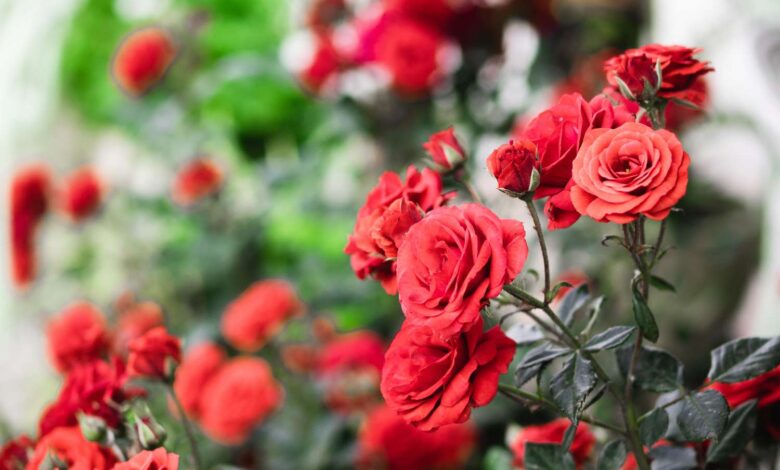The Timeless Beauty and Significance of Roses

Introduction to Roses
‘Roses are esteemed in flowers, celebrated for their timeless beauty and profound cultural significance. With their myriad species and varieties, roses present an array of colors and distinct fragrances, each possessing a unique charm. Known botanically as the genus Rosa, these flowers have been cultivated and admired for centuries across different civilizations, enthralling artists, poets, and horticulturists alike with their elegance and allure.
The world of roses is vast, encompassing over 300 species and thousands of cultivars. From the classic hybrid tea roses and floribundas to the more intricate miniature and climbing varieties, each type offers its spectacular display of blooms and fragrances. Their colors range from the purest whites and softest pinks to the deepest reds and vibrant yellows, each hue contributing to a diverse palette that inspires awe and admiration.
Roses are deeply embedded in cultural traditions around the globe. In ancient Greece and Rome, they were symbols of love and beauty, often associated with deities like Aphrodite and Venus. In medieval Europe, roses became emblematic in the context of chivalry and courtly love. The intricate art of rose breeding flourished Throughout the 18th and 19th centuries, contributing to the variety of roses we revel in today.
The symbolic meanings of roses extend beyond their aesthetic appeal. Red roses, for example, are universally recognized as symbols of love and passion. White flowers represent purity and innocence, whereas yellow roses evoke friendship and joy. This symbolism has permeated cultural expressions, from literature and art to religious and ceremonial contexts, reinforcing the rose’s status as a flower of immense emotional and symbolic weight.
Roses’ enduring beauty and significance reflect their rich history and the myriad ways they continue to touch our lives, making them a subject of continuous admiration and respect.
The History and Cultural Significance of Roses
The history of roses is as rich and diverse as the flower itself, with its cultivation tracing back several millennia. Evidence indicates that roses were first cultivated around 5,000 years ago in ancient Mesopotamia. From there, they spread to ancient civilizations such as Egypt, Greece, and Rome, where they were revered for their beauty and intoxicating fragrance. The Romans, in particular, appreciated roses for their multifaceted uses – from medicinal purposes to perfumes and even as symbols of vanity and decadence in their lavish feasts.
In ancient Egypt, roses were esteemed for their connection to the divine. They were often associated with the goddess Isis and used in funerary practices to honor the deceased. Similarly, in Greek mythology, roses were linked to beauty and love, believed to have originated from the tears of Aphrodite and the blood of her lover Adonis. These mythological roots further cemented the rose’s status as a symbol of love, passion, and purity across different cultures.
The Victorian era was a critical period in the history of roses, mainly through the language of flowers, also known as floriography. Roses became essential in conveying unspeakable emotions and messages when social etiquette restricted open expressions of affection and sentiment. Each color of the rose carried a specific meaning, enabling people to communicate a range of sentiments from love and admiration to secrecy and sorrow.
Roses also hold cultural significance in various societies around the world. In Persia, now Iran, roses are deeply embedded in art and literature, symbolizing divine love and beauty. In royal gardens throughout Europe and Asia, roses were cultivated as representations of wealth and elegance. Today, roses play an integral role in contemporary celebrations such as weddings and anniversaries, symbolizing enduring love and commitment.
The timeless allure of roses transcends generations, attesting to their enduring beauty and profound significance within human culture. Their rich history and cultural importance underscore why they remain cherished and iconic from antiquity to modern times.
Growing and Caring for Roses
With their elegant beauty and timeless appeal, roses are a cherished addition to any garden. Successfully growing and caring for roses requires careful consideration and adherence to several fundamental principles. Selecting the correct type of rose is fundamental; options range from hybrid teas and floribundas to climbing and shrub roses. Each type has unique attributes and care requirements, so match the rose variety to your climate, garden space, and personal preferences.
Planting roses starts with choosing A location with at least six hours of sunlight daily. Roses thrive in full sun, which encourages robust growth and prolific blooming. The soil should be well-drained, rich in organic matter, and somewhat acidic, with a pH of 6.0 to 6.5. Enhance soil quality by incorporating compost or well-rotted manure, which enriches nutrient content and promotes healthy root development.
Watering is another crucial aspect of rose care. Newly planted roses need consistent moisture, so water. During their first growing season, they grew profoundly and consistently. Mature roses should be watered weekly, supplying about one inch of water per session. Watering at the soil level is essential to prevent foliage fungal diseases caused by splashing water. Mulching helps retain soil moisture and temperature stability while suppressing weeds, making it an invaluable practice in rose cultivation.
Pruning roses is vital for maintaining plant health and encouraging blooms. Prune in early spring when new growth begins, removing dead or damaged canes and cutting back healthy canes by one-third to a half. This practice stimulates growth and shapes the plant. Summer deadheading, removing spent flowers, promotes continuous blooming throughout the season.
Pest and disease management is imperative for growing healthy roses. Common issues include aphids, spider mites, black spots, and powdery mildew. Introduce beneficial insects such as ladybugs for natural pest control and avoid chemical pesticides. Opt for organic fungicides or a homemade baking soda and water solution to manage diseases. Implementing crop rotation and selecting disease-resistant varieties further bolsters your rose garden’s resilience.
Adopting sustainable gardening practices, such as utilizing organic fertilizers and compost, reduces environmental impact and fosters a thriving ecosystem. By following these guidelines, gardeners can enjoy the timeless beauty and significance of well-cared-for roses.
The Symbolism and Uses of Roses
The rose is one of the most culturally significant flowers, universally recognized for its beauty and intricate symbolism. Different colors of roses convey distinct emotions and messages. Red roses, for example, are most commonly associated with love and passion. They are often exchanged on Valentine’s Day and staple in romantic gestures. White roses symbolize purity, innocence, and reverence, frequently used in weddings and funerals to convey respect and honor.
Yellow roses represent friendship and joy. These cheerful blooms are excellent for celebrations and expressing platonic care. Pink roses, ranging from pale blush to deep magenta, signify admiration, gratitude, and elegance, making them popular for expressing subtle affection and appreciation. Each color has unique connotations, allowing individuals to convey specific feelings and messages through floral choices.
Beyond their symbolic meanings, roses have versatile uses in various contexts. As gifts, roses are presented to convey heartfelt messages, celebrate milestones, or mark special occasions. In decoration, their aesthetic appeal enhances the ambiance of weddings, festivities, and corporate events. Additionally, roses find a place in homes and gardens, admired for their fragrance and visual appeal.
The uses of roses extend beyond decoration and gifts. The rose’s quintessential fragrance is a cherished ingredient in numerous iconic scents in perfumery. Culinary uses of roses include rosewater, which adds a distinct flavor to desserts and beverages. In contrast, rose petals are in gourmet dishes and herbal teas, beloved for their delicate taste and health benefits. Historically, roses have also been used in medicinal remedies. Their natural compounds contribute to skin care products and holistic treatments, valued for their anti-inflammatory and soothing properties.





